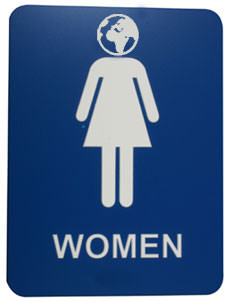There’s No Delicate Way to Put This …
Hello ladies. Would you consider reusable menstrual items? Please stay with me.
Hello ladies.
Would you consider reusable menstrual items?
Please stay with me.
I do not sell these items, nor am I connected to the companies that make them. I’m a mom who’s been cloth-diapering her baby for six months, to save money, my son’s health and the environment. Only recently did I realize that while I’ve been feeling ecologically virtuous, I’ve also been throwing out tampons and pads every month for more than 20 years of my life, and have another 20-plus years to do so.
I did some research and was appalled. I claim, like most people, to be concerned about the desperate state of the planet, yet I never challenged the disposable monolith we live in. A sampling:
There are 85 million women of menstruating age in North America. Conservative estimates are that the average woman disposes of between 10,000 and 15,000 tampons, pads and applicators in her lifetime1. That’s about 250 to 300 pounds of waste per woman.
In 1999, about 2.5 million tampons, 1.4 million pads, and 700,000 pantiliners were flushed away daily2.
Waste consultant Franklin Associates reports that 13.5 billion pads and 6.5 billion tampons, plus their packaging, ended up in landfills or sewage systems in 19983. In the United States and Canada alone, more than 12 billion pads and tampons are tossed annually4.
Disposable pads are made with polyethylene plastic. Producing polyethylene contributes to global warming and depletes the ozone, while emitting sulfur and nitrogen oxides, which add to acidification5.
According to the Center for Marine Conservation, more than 170,000 tampon applicators were collected along U.S. coastal areas between 1998 and 19996. The Ocean Conservancy collected and cataloged debris along U.S. coastlines between 2001 and 2006, finding that tampon applicators made up 2.2 percent of the total debris field, more than syringes, condoms and plastic six-pack rings combined7.
Most women are not aware that safe, ecologically sound, lower-priced alternatives exist. We have been conditioned since childhood by slick commercials for disposable products. The companies that make reusable products don’t have the revenue from massive repeat sales, like tampon and pad companies do, to advertise on television and in major print outlets. Word of mouth is vital.
Most obvious among “green” alternatives are washable cloth pads and pantiliners. These are not your grandmother’s cloth pads. Today they’re available on the Internet and come in a wide variety of funky patterns and materials, from hemp to organic French terry cotton to microfleece.
Washing cloth pads is actually easy — after rinsing and soaking them in a container of cold water with a secure lid, you can run them through the laundry and machine or line-dry them. Done.
If you are out or at work, you can store the used pads in a “wet” bag and soak them when you get home.
A few other useful sites are www.lunapads.com, www.gladrags.com and www.greenyour.com.
Then there is the menstrual cup. A flexible bell shape, it’s made of medical-grade silicone that softens with body heat — the same material used for heart valves — or latex. It is worn low in the vagina, just beyond the opening. When inserted properly, you can’t feel it. It is physically impossible for it to get “lost” inside.
While the cup looks intimidating, it is folded to a very manageable size before inserting. There are numerous folding techniques, and different techniques work for different women. It is not painful to use.
Menstrual cups can last, with proper care, up to 10 years. They cost $20 to $30. In 10 years, the average woman spends about $500 on tampons and pads.
Menstrual cups can be worn for up to 12 hours at a time, including overnight. Unlike tampons, they are not associated with toxic shock syndrome. You empty, wash and reinsert it two or three times in a 24-hour period. You will almost never, considering how long you can wear the cup, have to empty it in a public restroom.
When you try it for the first time, relax and remember it takes practice. Most women need about three monthly cycles to master the technique. Once you have it down, it takes only a few seconds to insert or remove the cup.
The initial reaction of nearly all women to the menstrual cup is “Gross!” But the cup is not messy. It holds a full ounce. The entire average monthly flow is two to four ounces. Most women, after wearing the cup for 12 hours on their heavy-flow days, will find that it is less than half full.
You can find lots of information and support online. A good instructional video is on YouTube.
Also, www.ecomenses.com has helpful information and pictures on menstrual cups, cloth pads and sea sponges.
The Diva Cup is manufactured in Canada. There’s also the Keeper (not for those with latex allergies), the Moon Cup and the Lunette. Each site has extensive FAQ sections, especially the Diva Cup site, which has more than 100 answers to different concerns.
This is one decision you can make that will have an immediate impact on the environment. You may not be able to afford solar panels or a biodiesel vehicle. Maybe you’re not ready for a compost toilet. But you can do this.
Nobody makes a greater mistake, wrote Edmund Burke, than s(he) who did nothing because s(he) could only do a little.
Eunice Wong is an actor based in New York.
References:
1P2Pays — “Recycling and waste reduction statistics: The Disturbing Truth” 2Women’s Environmental Network — “Seeing Red: Sanitary Protection and the Environment” 3Health News Digest 4P2Pays — “Recycling and waste reduction statistics: The Disturbing Truth” 5http://www.greenyour.com/body/personal-care/feminine-hygiene/tips/choose-cloth-menstrual-pads?subject=9133&category=9484 6E: The Environmental Magazine — “Inner Sanctum: The Hidden Price of Feminine Hygiene Products” 7Ocean Conservancy — “The National Marine Debris Monitoring Program: Total Debris Collected/National”
Your support matters…Independent journalism is under threat and overshadowed by heavily funded mainstream media.
You can help level the playing field. Become a member.
Your tax-deductible contribution keeps us digging beneath the headlines to give you thought-provoking, investigative reporting and analysis that unearths what's really happening- without compromise.
Give today to support our courageous, independent journalists.






You need to be a supporter to comment.
There are currently no responses to this article.
Be the first to respond.